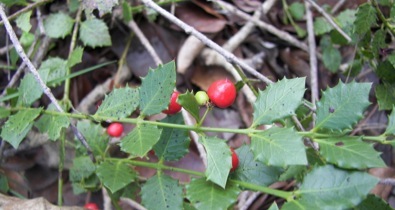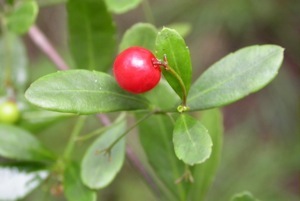Crossopetalums: Edible Berries & Medicine
When I was an undergrad in music it was a revelation to learn that by studying music you also studied history: There’s no sense in writing a symphony when all the musicians are off fighting a long war. You write for small groups, perhaps of which the best known are string quartets. Music reflects what is going on in a society.
When you study plants you also study history, but through names. By tracing names and how they change you get hints as to the plants’ use and importance. My own observation about plants in the New World is that most Europeans who came over tended to be faithful to what the Indians called a plant or how they used it except English speakers. Anglos used their own terms. A berry that might be known in three Indian languages as Old Lady’s Earrings, The Earring Plant, or Monkey’s Earrings, becomes the Quail Berry in English, and not a quail within a thousand miles. Often English-speaking families made make up their own names for plants proliferating such terms as “Mary’s Flower” “Indian Root” and “Pig Weed.” At last count there were some 18 different “pig weeds” in the United States, some of them edible, many of them not.
I run into non-standard names all the time. I had a neighbor refer to a plant as “Indian Root” whereas the local Indians have probably not eaten it for well over a century, if not far longer. While Indian, Spanish and French terms are often helpful, the English speakers also used a variety of terms that confuse things. For example, poison, snake, and horse have all been used to mean “wild.” Sometimes a so-called local “Poison Berry” is not poisonous at all, just wild, or rank as in radish, horse radish. And so we come to the Christmas Berry and the Maiden Berry.
Neither term seems to have been in use a century ago, and where they came from is anyone’s guess but they are for the Crossopetalum ilicifolium, upper left, and Crosspetalum rhacoma, right. In fact, the Maiden Berry, right, appears to be a rather recent appellation but wide spread. And a word like “Christmas” is also new, for plants. It is but 900 years old whereas some plants have had the same name for thousands of years through different languages. The use of “Maiden” with plants dates back to 1589 and usually means a plant that has not budded or been trimmed or transplanted.
Both berries are somewhat rare and their drupes readily enjoyed by birds. And while the berries are edible the most common use for these plants have been to make a decoction from the roots to treat kidney stones. In Cuba a decoction of the root and leaves is made for use as a diuretic and to treat kidney inflammation. While it is fine to eat the berries and spread them seeds around they are endangered and digging one up now for a kidney stone would not be legally wise, at least in the United States.
Crossopetalum (kros-so-PET-ah-lum) comes from the Greek words krossos and petalon, meaning respectively fringe and petal, referring to the leaves. Ilicifolium (ill-liss-ee-FOH-lee-um) means having leaves that look like a holly, and the Christmas Berry does. One easy way to remember its name. Rhacoma (rah-KO-ma) though often ascribed to Latin, comes from the Greek word rhakoma, meaning rags, or threadbare, rakos (RA-kos.) The Romans used the word for rhubarb, which has wavy margins. C. uragoga (oo-rha-GO-gah urine promoting) is also used as a diuretic.
Green Deane’s “Itemized” Plant Profile
IDENTIFICATION:
C. Ilicifolium: Low shrub with downy twigs, forming handsome mats on the ground. Leaves holly-like, oval or ovate, spiny-toothed, half inch long. Flowers reddish, small four or five petals, short talked clusters, fruit bright red, nearly round, mealy, one seed. C. rhacoma, shrub or tree, erect to 20 feet, leaves opposite, in whorls of three, oval to elliptical, with a few teeth towards tip. Flowers small, four petaled, fringed in red or purple, in long-stalked clusters. Fruit obovoid, red or maroon, to a quarter inch long, with a single stone holding many seeds.
TIME OF YEAR:
C. Ilicifolium in the warmer months, C. rhacoma all year
ENVIRONMENT:
Hammocks, pine lands for both, C. rhacoma also sand dunes and Everglades
METHOD OF PREPARATION:
Ripe fruit edible raw



